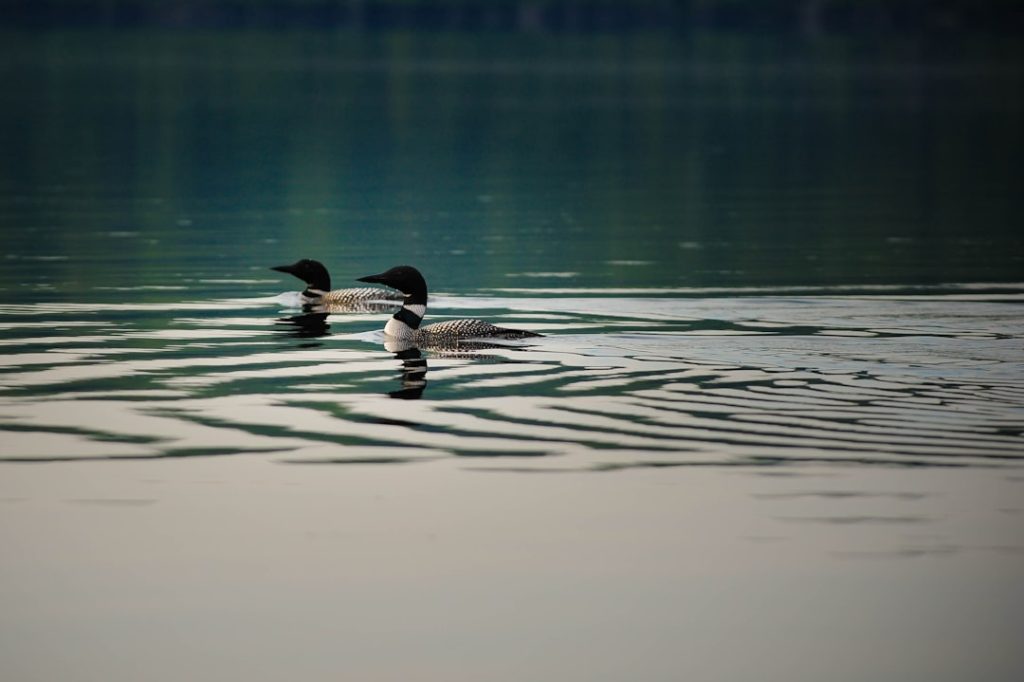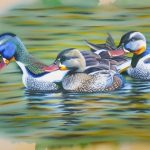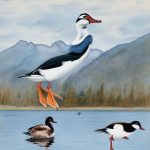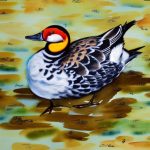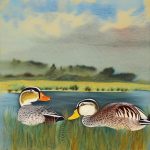Mallard ducks, scientifically known as Anas platyrhynchos, are one of the most recognizable and widespread duck species in the world. They are found in various habitats, including wetlands, marshes, lakes, and rivers, across North America, Europe, and Asia. Mallards are known for their striking iridescent green heads, white neck ring, and chestnut-brown chest. The females, or hens, are mottled brown with an orange bill. These ducks are highly adaptable and can thrive in both urban and rural environments.
Mallards are dabbling ducks, which means they feed by tipping forward in the water to reach aquatic plants, insects, and small fish. They are also known for their distinctive quacking calls, which are a common sound in wetland areas. Mallards are migratory birds, with some populations traveling long distances between their breeding and wintering grounds. They are also popular game birds and are hunted for sport and food in many parts of the world. Despite this, mallard populations remain stable and are not considered to be at risk of extinction. These ducks play a vital role in their ecosystems by dispersing seeds and controlling insect populations, making them an important species to study and conserve.
Table of Contents
Key Takeaways
- Mallard ducks are a common species of waterfowl found throughout North America and Eurasia.
- Mallard ducks exhibit seasonal breeding behavior, with mating typically occurring in the spring and early summer.
- Courtship and pair bonding in mallard ducks involve elaborate displays and vocalizations to attract a mate.
- Female mallard ducks build nests in secluded areas near water and lay a clutch of 8-13 eggs.
- After the eggs are laid, the female mallard duck incubates them for about 27-28 days until they hatch.
Seasonal Breeding Behavior
Mallard ducks are known for their seasonal breeding behavior, which typically occurs in the spring and summer months. As the days grow longer and temperatures rise, mallards begin to exhibit courtship behaviors and pair off for the breeding season. Breeding pairs can form as early as late fall or as late as early spring, depending on the location and climate. Mallards are monogamous during the breeding season, with pairs forming strong bonds that can last for the duration of the nesting period.
During the breeding season, male mallards engage in elaborate displays to attract females. These displays can include head bobbing, tail wagging, and vocalizations. Males also compete with each other for the attention of females, engaging in aggressive behaviors such as chasing and fighting. Once a pair has formed, they will engage in preening each other’s feathers and synchronized swimming as a form of bonding. Breeding pairs will then seek out a suitable nesting site, typically near water with plenty of vegetation for cover. The female will construct the nest using grasses, reeds, and other plant materials, creating a shallow depression lined with down feathers for insulation.
Courtship and Pair Bonding
Mallard ducks engage in complex courtship rituals as part of their breeding behavior. These rituals involve a series of displays and behaviors designed to attract a mate and form a strong pair bond. Male mallards are particularly active in their courtship displays, using a combination of visual displays, vocalizations, and physical movements to impress females. These displays can include head bobbing, tail wagging, and wing flapping, all of which are intended to showcase the male’s fitness and attractiveness.
Once a female has been attracted to a male’s displays, the pair will engage in synchronized swimming and preening behaviors as a way of strengthening their bond. Preening involves the careful grooming of each other’s feathers, which not only helps to maintain their plumage but also serves as a form of social bonding. Mallards are known for their synchronized swimming displays, where pairs will swim side by side or in circles together. These behaviors help to establish trust and communication between the breeding pair, ensuring that they are ready to cooperate in the nesting and rearing of their offspring.
The courtship and pair bonding behaviors of mallard ducks are essential for ensuring reproductive success. By forming strong bonds with their mates, mallards can work together to build a nest, incubate eggs, and protect their young from predators. These behaviors also help to reinforce the social structure within mallard populations, ensuring that breeding pairs are able to successfully raise their offspring in a challenging and competitive environment.
Nesting and Egg Laying
Once a breeding pair has formed a strong bond through courtship rituals, they will seek out a suitable nesting site to lay their eggs. Mallard ducks prefer to nest near water, such as in marshes, wetlands, or along the edges of lakes or rivers. The female will construct the nest using grasses, reeds, and other plant materials, creating a shallow depression lined with down feathers for insulation. The nest is typically hidden among dense vegetation to provide protection from predators and the elements.
Mallard hens lay an average of 8-13 eggs per clutch, although larger clutches have been recorded. The eggs are oval-shaped and vary in color from off-white to pale green or blue. The female will lay one egg per day until her clutch is complete, at which point she will begin incubating the eggs to keep them warm and facilitate embryonic development. The incubation period for mallard eggs is approximately 26-28 days, during which time the female will rarely leave the nest except to feed briefly.
The nesting and egg-laying behaviors of mallard ducks are crucial for ensuring the survival of their offspring. By carefully selecting a nesting site and constructing a well-hidden nest, females can reduce the risk of predation and ensure that their eggs have the best chance of hatching successfully. Once the eggs have been laid, the female’s role shifts to that of an attentive parent, diligently incubating her eggs to protect them from harm until they are ready to hatch.
Incubation and Hatching
After the female mallard has completed laying her clutch of eggs, she will begin the process of incubating them to facilitate embryonic development. Incubation typically lasts for 26-28 days, during which time the female will rarely leave the nest except to feed briefly. The female’s body provides the heat necessary for the eggs to develop properly, and she carefully arranges them within the nest to ensure that they receive even warmth.
During incubation, the female will turn her eggs regularly to prevent the embryos from sticking to the shell membranes and ensure that they receive adequate oxygen. She will also defend her nest fiercely against potential predators or disturbances that could threaten the safety of her developing offspring. As the incubation period progresses, the female’s behavior becomes increasingly focused on protecting her eggs and ensuring their successful hatching.
Once the incubation period is complete, the eggs will begin to hatch over a period of 24-36 hours. The hatching process is initiated by the ducklings inside the eggs using their egg tooth—a small projection on their beak—to break through the shell. The newly hatched ducklings are covered in down feathers and are capable of walking and swimming shortly after hatching. The female will lead her brood away from the nest to a nearby body of water within 24 hours of hatching to begin teaching them how to feed and navigate their new environment.
The incubation and hatching process is a critical stage in the reproductive cycle of mallard ducks. By carefully tending to her eggs and protecting them from harm during incubation, the female ensures that her offspring have the best chance of survival once they hatch. The hatching of ducklings marks the beginning of a new generation of mallards and sets the stage for the next phase of parental care and protection.
Care and Protection of Ducklings

Once mallard ducklings have hatched from their eggs, they require careful attention and protection from their parents to ensure their survival. The female mallard plays a crucial role in caring for her brood, leading them to water shortly after hatching where they can learn to swim and find food. Ducklings are precocial birds, meaning they are born with their eyes open and are capable of walking and swimming shortly after hatching.
The female mallard will lead her brood to water within 24 hours of hatching, where she will teach them how to find food by dabbling for aquatic plants and insects. She will also protect them from predators by keeping them close and leading them to safety if she senses danger. Male mallards may also play a role in protecting ducklings from predators or other threats while providing additional guidance as they learn essential survival skills.
Mallard ducklings grow rapidly during their first few weeks of life, developing flight feathers at around 50-60 days old. During this time, they rely on their parents for protection and guidance as they learn how to find food and avoid predators. The care and protection provided by mallard parents during this critical period are essential for ensuring that ducklings reach maturity successfully.
Post-Breeding Behavior
After successfully raising their brood of ducklings to independence, mallard parents undergo a period of post-breeding behavior as they prepare for migration or wintering. Once ducklings have fledged and become capable of flight, they will gradually become more independent from their parents as they learn to find food on their own and develop their flying skills.
Mallard parents may undergo molting during this time as they replace worn feathers with new ones in preparation for migration or wintering. They may also join larger flocks of non-breeding mallards as they prepare for their next phase of life outside of the breeding season. Mallards are migratory birds that travel long distances between their breeding grounds and wintering areas, so post-breeding behavior often involves preparing for these long journeys.
As summer turns into fall, mallards may gather in large flocks on bodies of water where they can find food before beginning their migration southward. These flocks provide safety in numbers as mallards prepare for their annual migration or wintering period. Post-breeding behavior marks a transition from the intense focus on reproduction during the breeding season to preparing for migration or wintering as part of mallards’ annual life cycle.
In conclusion, mallard ducks exhibit fascinating seasonal breeding behavior that includes courtship rituals, nesting and egg-laying activities, incubation and hatching processes, as well as care and protection of ducklings. These behaviors are essential for ensuring reproductive success and the survival of future generations of mallards. Understanding these behaviors provides valuable insights into the natural history and ecology of this iconic duck species.
If you’re interested in learning more about the breeding habits of mallard ducks, you might also want to check out this article on when guinea fowl lay eggs. Understanding the reproductive patterns of different bird species can provide valuable insights for poultry enthusiasts and farmers alike.
FAQs
What are mallard duck breeding habits?
Mallard ducks typically breed in the spring and early summer, with the peak of breeding activity occurring between March and June.
Where do mallard ducks build their nests?
Mallard ducks build their nests on the ground, often in grassy areas near water such as ponds, lakes, or marshes. They may also nest in urban areas, such as in parks or on golf courses.
How many eggs do mallard ducks lay?
Mallard ducks typically lay 8-13 eggs in a single clutch, although the average is around 10 eggs. The female mallard will lay one egg per day until the clutch is complete.
How long does it take for mallard duck eggs to hatch?
Mallard duck eggs take about 23-30 days to hatch, with the average incubation period being around 28 days. The female mallard will incubate the eggs and only leave the nest briefly to feed.
Do mallard ducks mate for life?
Mallard ducks are not strictly monogamous and do not mate for life. However, they do form pair bonds that can last for the duration of the breeding season.
What do mallard duck chicks eat?
Mallard duck chicks primarily eat insects, small crustaceans, and other invertebrates. They may also consume small fish and aquatic plants as they grow older.
Meet Walter, the feathered-friend fanatic of Florida! Nestled in the sunshine state, Walter struts through life with his feathered companions, clucking his way to happiness. With a coop that’s fancier than a five-star hotel, he’s the Don Juan of the chicken world. When he’s not teaching his hens to do the cha-cha, you’ll find him in a heated debate with his prized rooster, Sir Clucks-a-Lot. Walter’s poultry passion is no yolk; he’s the sunny-side-up guy you never knew you needed in your flock of friends!

